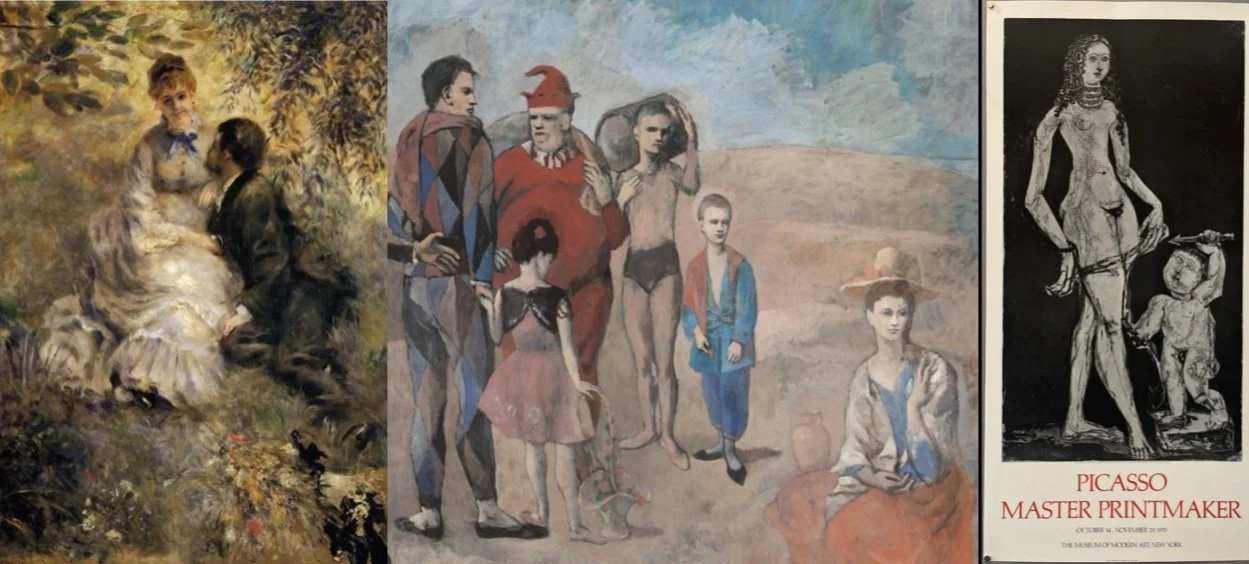Film Essay: The Art in "Tootsie"
Recently celebrating its 40th anniversary, “Tootsie” is a marvel of a film. First off it has amazing acting performances. Dustin Hoffman and Jessica Lange are especially fantastic. Bill Murray is unsurprisingly hilarious as Hoffman’s roommate. The film has a terrific script by Larry Gelbart and Murray Schisgal that is dramatic, biting and also filled with well-timed comedy. It is also very well directed and visualized by Sydney Pollack (definitely check out another film of his titled “Three Days of the Condor” with Robert Redford).
I recently decided to watch “Tootsie” specifically to see if there were any interesting pieces of artwork in the film. And wow, yes there were! Specifically in Michael Dorsey’s apartment, the Southwest General soap opera set and Sandy Lester’s bedroom. The artwork pointedly relates to the characters in the film, and also brings up interesting ideas about character backstories and the lives of the characters before the film’s beginning.
Michael Dorsey’s Apartment:
“Venus and Cupid, After Cranach”, Pablo Picasso (1949)
This is one of two Picasso posters present in the apartment set. It is a poster for a Picasso exhibit at the Museum of Modern Art that took place October 14-November 29 in 1970. The image is of a semi-terrifying print of Venus and Cupid, their faces abstracted and their bodies proportions elongated and distorted. This work is modeled, as the title suggests, after Venus and Cupid (1530) by Lucas Cranach the Elder. Here we see the mirror image of the Picasso, with Cupid now on the left. They are far more realistic and photo real.
Lucas Cranach the Elder painted at least 20 of these Cupid and Venus paintings over a period of 20 years. He was clearly taken by the subject of Venus and her child Cupid. There are a number of reasons why the presence of this image in Michael’s apartment is interesting. For one thing: it depicts a mother and her child. Michael is incapable of being in a relationship at the beginning of the film. He is an egotistical and not likable. Through his experience becoming and living as Dorothy, a woman, he becomes a better and more thoughtful human being.
I also think it is interesting to look at the doubling nature of both Picasso’s print work and also Cranach’s obsession with Venus and Cupid. Just as Cranach painted the same image again and again, Picasso would copy the Old Master’s works. For example, his near obsessive descent into Diego Valasquez’s painting Las Meninas. While in Barcelona in 2019, I saw in the Museu Picasso practically two whole rooms filled with adaptations of small bits or the entirety of the painting. Dorothy Michaels is a doubling of Michael Dorsey. But she is, crucially, his better half.
There is another interesting point concerning this work. The fact that Michael has this poster means that he went to this exhibit 12 years prior to the film’s start. There is an interesting bit of character backstory there. He would have probably been 33 or so. And this work stood out to him.
If you’d like to read more about this print by Picasso, take a look at this terrific history of the piece here.
The poster from the 1970 exhibition.
“Venus and Cupid”, Lucas Cranach the Elder (1530). The image that Picasso based his print off of. You can see the orientation of the figures matches exactly (including the fact that Cupid is on a square rock).
Venus and Cupid with a Honeycomb, Lucas Cranach the Elder, (1530). I had the pleasure of seeing this iteration of the scene at the Borghese Gallery in Rome while in Italy recently.
“Family of Saltimbanques”, Pablo Picasso (1905)
This poster is just barely perceptible in the film. In the screenshot below, you can see it on the left side of the image, to the left of Michael’s bed.
This is one of my favorite Picasso paintings. It is at the National Gallery of Art in Washington D.C. and it is a wonder to behold in person. You just feel like you’re being enveloped by this massive painting. It depicts a group of traveling performers (harlequins, jesters, acrobats) in a desolate landscape. All of them appear to be in their own world. Isolated and alone.
This theme of isolation is present in Tootsie too. At the beginning of the film, Michael is creatively isolated. Incapable of moving forward in the industry because he is so much of a perfectionist and impossible to work with. He’s closed off. When he becomes Dorothy he experiences the success that he has been yearning for, but is still isolated due to the fact that he’s lying to everyone at the soap opera about his true identity. He is burdened by his secret. Picasso’s painting seeks to paint melancholic actors, between performances, trying to find their way. Perhaps Michael sympathized with them.
Also, worth noting quickly the Laurence Oliver poster behind Michael. This is for the 1960 film “The Entertainer” which tells the story of a third-rate music hall performer who tries to keep his career going in a dying industry. Though not entirely connected to Michael’s story, it still deals with an aging performer who is not progressing in their career like they’d want to.
The exhibit at the National Gallery of Art that ran from late 1980 to 1981. You can see the Family of Saltimbanques at the center left.
The Set of Southwest General:
“The Lovers”, Pierre-Auguste Renior (1875)
I think this is a brilliant piece of set-dressing. On the walls of Dr. Brewster’s office is the idyllic painting “The Lovers” by Pierre-Auguste Renoir. It is a wonderful example of a piece of art serving as a representation of character. Brewster probably put this poster up because he sees himself in the gentleman who woos woman in a romantic fashion like the fellow in the painter. In reality, he is inappropriate towards women in the workplace, constantly kissing and making advances on them. April, played by Geena Davis, tells Dorothy that the actor John Van Horn (who plays Brewster in the soap opera) “kisses all the women on the show. Must be in his contract. We call him ‘the tongue’”.
This art placement blurs the lines between performance and reality. Brewster is inappropriate to women in the world of the soap opera and Van Horn is the same way on set. He and his soap opera character mirror one another.
Dorothy, and the audience, see right through Brewster (and Van Horn). She doesn’t kiss him during the filming of a scene and instead slaps him and puts him in his place. She tells him:
“Do you really think I’m someone you can grope in the broom closet and then not consider a threat? I’m afraid, Dr. Brewster, that you have underestimated me. If you want to win me over, you’ll have to deal with my mind, not my lips.”
When he tries to woo her later in the film, he sings “I’ll Know” from Guys and Dolls on the street outside of her apartment (reminiscent of “On the Street Where You Live from My Fair Lady). Then, in her apartment, he tells her “I’ve never wanted a woman this much”. Van Horn takes on the hopeless romantic act from the Renoir painting, once again seeing himself as an impressionistic lover.
The painting resides in the National Gallery in Prague. Even though you only see in bottom half of the painting, I knew immediately it was a Renoir. His flowing brushstrokes are so distinctive.
Sandy’s Apartment:
“Chez Panisse 2nd Birthday” (1972)
Michael’s friend Sandy wants to be a successful actress. Unfortunately, things aren’t working out. On the wall of her bedroom, we see a David Lance Goines poster for the Chez Panisse 2nd Birthday Party. Chez Panisse is a restaurant in LA that pioneered the farm-to-table movement. The name of the restaurant is taken from the last name of the character Fanny from a Marcel Pagnol trilogy of films. This poster represents everything that Sandy wants: a connection to prestige filmmaking, the exclusivity of an invitation and also Los Angeles and stardom. But all of this is just a dream. It is simply a poster on her wall.
Conclusions:
The works that I’ve highlighted illuminate Michael, Dr. Brewster and Sandy’s views of themselves. That’s the power of placing works on the walls of a film set. We know as a viewer that the character who resides in that place picked those pieces out and put them on the wall before the film began. They are a part of the cinematic environment and, through analysis, we can figure out why the character picked that work and how it has an effect on the film as a whole.

















